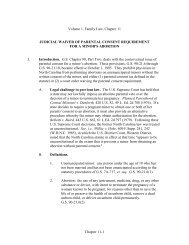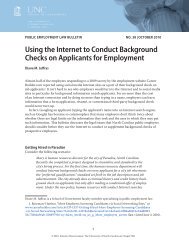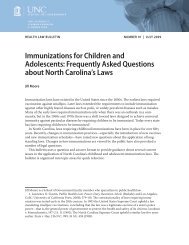<strong>Health</strong> Law Bulletin No. 82 September 2005The assumption throughout this bulletin is thatthe health department is not a party <strong>to</strong> the case. Whenit is a party <strong>to</strong> a case, the opposing party will usuallyuse devices other than a subpoena <strong>to</strong> obtainin<strong>for</strong>mation, such as interroga<strong>to</strong>ries or requests <strong>to</strong>produce documents, and the opposing party willnormally contact the department’s counsel first, whocan then advise the department how <strong>to</strong> proceed. Incontrast, when a health department is not a party <strong>to</strong> acase, the party seeking the records ordinarily willdeliver a subpoena directly <strong>to</strong> the departmentemployee thought <strong>to</strong> have the records, not <strong>to</strong> thedepartment’s counsel. This bulletin is there<strong>for</strong>e aimedat the health department employee who has receivedor may receive a subpoena and who must decide, atleast initially, how <strong>to</strong> proceed. 1Readers should keep in mind that this bulletinoffers general guidance only. It merely sketches outsome of the records that health departments musthold in confidence; it does not attempt <strong>to</strong> specify thevarious kinds of records within each category.Further, health departments should decide on aprocedure <strong>for</strong> responding <strong>to</strong> subpoenas that meetstheir own needs. Some may want <strong>to</strong> alert theircounsel whenever they receive a subpoena. Othersmay decide <strong>to</strong> adopt a pro<strong>to</strong>col <strong>for</strong> departmentpersonnel <strong>to</strong> follow, consulting with counsel asquestions arise. Readers should feel free <strong>to</strong>incorporate any of the in<strong>for</strong>mation in this bulletin indeveloping their own procedure <strong>for</strong> responding <strong>to</strong>subpoenas.1. Other articles are available on the responsibilities ofmental health facilities and schools in responding <strong>to</strong>subpoenas. See John Rubin and Mark Botts, <strong>Responding</strong> <strong>to</strong><strong>Subpoenas</strong>: A Guide <strong>for</strong> Mental <strong>Health</strong> Professionals,POPULAR GOVERNMENT, Summer 1999, at 27–38 (posted atwww.sog.unc.edu/pubs/electronicversions/pg/botts.pdf);John Rubin, <strong>Subpoenas</strong> and School <strong>Records</strong>: A SchoolEmployee’s Guide, SCHOOL LAW BULLETIN, Spring 1999, at1–11 (posted at www.sog.unc.edu/pubs/electronicversions/slb/sp990111.pdf). Those articles were written be<strong>for</strong>e the2003 changes <strong>to</strong> Rule 45 of the North Carolina Rules ofCivil Procedure, the general rule governing subpoenas.Those changes are identified where relevant in this bulletin,but they do not affect the basic approach recommended inthe previous articles on how <strong>to</strong> balance the obligations <strong>to</strong>respond <strong>to</strong> a subpoena and protect confidential in<strong>for</strong>mation.General PrinciplesQuestion 1. Are there different types ofsubpoenas?Yes. There are two basic types:• a subpoena <strong>to</strong> testify (also called a witnesssubpoena), which directs the person namedin the subpoena <strong>to</strong> appear <strong>for</strong> the purpose ofgiving testimony; and• a subpoena <strong>to</strong> produce documents (alsocalled a document subpoena or subpoenaduces tecum), which directs the namedperson <strong>to</strong> appear and produce documents.The subpoena that you as a health departmentemployee receive may not be specifically labeled as awitness subpoena or document subpoena, but it willstate whether you are being called <strong>to</strong> testify, producedocuments, or both. The attached <strong>for</strong>m subpoena,issued by the North Carolina Administrative Officeof the Courts, contains boxes that the subpoenaingparty checks off (in the section entitled “YOU ARECOMMANDED TO”), which indicate the purpose<strong>for</strong> which you are being subpoenaed. 2 The <strong>for</strong>m istypically used in state court proceedings, but it is notrequired and the subpoena you receive may be<strong>for</strong>matted differently.Question 2. In what kinds of proceedingscan a subpoena be used?A subpoena can be used <strong>to</strong> summon its recipient<strong>to</strong> a wide range of proceedings, including:• civil and criminal trials and hearings(including juvenile court proceedings) instate or federal court;• depositions in civil cases, which areproceedings be<strong>for</strong>e trial in which the parties<strong>to</strong> the case (the plaintiff and defendant) havethe opportunity <strong>to</strong> question witnesses andexamine documents;• arbitrations, which are like trials except thatthe “judge” who hears the evidence anddecides the case is often a private at<strong>to</strong>rneyselected by the parties; and2. See ADMINISTRATIVE OFFICE OF THE COURTS,NORTH CAROLINA JUDICIAL DEPARTMENT FORMS MANUAL,AOC-G-100 (Oct. 2003) (posted at www.nccourts.org/Forms/Documents/556.pdf).2
September 2005 <strong>Health</strong> Law Bulletin No. 82• hearings be<strong>for</strong>e an administrative law judge,administrative agency, or professionallicensing board.In all of these proceedings, the general principlesgoverning subpoenas are the same. There are somedifferences, however, in the procedural details, suchas how a subpoena is issued or how far a person canbe compelled <strong>to</strong> travel.This bulletin concentrates on trials, other in-courthearings, and depositions in state court, theproceedings <strong>for</strong> which health department employeesare most likely <strong>to</strong> receive a subpoena. Rule 45 of theNorth Carolina Rules of Civil Procedure, a set ofprocedures followed in state court, governssubpoenas <strong>for</strong> in-court proceedings (trials andhearings) in both civil and criminal cases. 3 Withminor differences, the rules on subpoenas areessentially the same <strong>for</strong> both types of cases. Rule 45also applies <strong>to</strong> subpoenas <strong>for</strong> depositions, which areused primarily in civil cases. For purposes of thisbulletin, the most important difference between an incourtproceeding, such as a trial, and a deposition isthat at a deposition, no judge is present <strong>to</strong> rule onwhether a subpoena is proper. This difference mayaffect the way you respond <strong>to</strong> a subpoena,particularly one that calls <strong>for</strong> the production ofconfidential in<strong>for</strong>mation (see Question 29, below).Question 3. Does a case have <strong>to</strong> bepending be<strong>for</strong>e a subpoena may be used?Generally, yes. For a party <strong>to</strong> obtain a subpoena,a case must have been initiated and must be pendingin the particular <strong>for</strong>um (civil court, criminal court,administrative agency, and so on). It is generallyimproper <strong>for</strong> a party <strong>to</strong> issue a subpoena when nocase is pending. 43. See G.S. 8-59, -61; G.S. 15A-801, -802.4. See North Carolina Rules of Professional Conduct,Ethics Op. 236 (North Carolina State Bar Ethics Comm.,Jan. 1997) (State Bar finds that it would be improper <strong>for</strong>at<strong>to</strong>rney <strong>to</strong> issue subpoena if no case is pending; opinionalso states that it would be improper <strong>for</strong> at<strong>to</strong>rney <strong>to</strong> issuesubpoena <strong>for</strong> time and place when no proceeding isscheduled, but revised Rule 45 now authorizes such asubpoena in the circumstances described in this bulletin); Inre Superior Court Order, 70 N.C. App. 63, 318 S.E.2d 843(1984) (Rule 45 does not authorize issuance of subpoenabe<strong>for</strong>e action has commenced), rev’d on other grounds, 315N.C. 378, 338 S.E.2d 307 (1986).Be<strong>for</strong>e the 2003 changes <strong>to</strong> Rule 45 of the NorthCarolina Rules of Civil Procedure, there also had <strong>to</strong>be some sort of proceeding scheduled <strong>to</strong> which therecipient was being subpoenaed. The 2003 changesmodified this requirement <strong>for</strong> subpoenas <strong>for</strong>documents (but not subpoenas <strong>to</strong> testify). Forexample, under the <strong>for</strong>mer rule, a party in a civil casewould have <strong>to</strong> schedule a deposition, <strong>to</strong> which theparty would then subpoena the cus<strong>to</strong>dian, even if theparty merely wanted <strong>to</strong> inspect documents in thecus<strong>to</strong>dian’s possession and did not want <strong>to</strong> take anytestimony. Under the revised rule, a party may obtaina subpoena in a pending case directing the recipient<strong>to</strong> produce documents at a designated time and place,such as the issuing party’s office, even though nodeposition or other proceeding is scheduled <strong>for</strong> thattime and place. 5In limited circumstances, a party may obtain asubpoena or its equivalent be<strong>for</strong>e a case is filed. Thus,some North Carolina agencies are authorized <strong>to</strong> issuesubpoenas <strong>for</strong> in<strong>for</strong>mation necessary <strong>to</strong> the agency’sinvestigation. See, e.g., G.S. 15A-298 (authorizing StateBureau of Investigation <strong>to</strong> issue administrative subpoenas<strong>to</strong> compel carriers <strong>to</strong> produce telephone records that arematerial <strong>to</strong> active criminal investigation). In the absence ofa statute authorizing the issuance of a subpoena be<strong>for</strong>e acase is filed, a party must ask a judge <strong>to</strong> issue an order <strong>for</strong>production of records. See, e.g., In re Superior Court Order,315 N.C. 378, 338 S.E.2d 307 (1986) (court has inherentauthority in some circumstances <strong>to</strong> issue order compellingproduction of records).5. The change in Rule 45 authorizing this proceduremay not be readily apparent. It is reflected in the followingitalicized portion of revised Rule 45(a)(2): “A command <strong>to</strong>produce evidence may be joined with a command <strong>to</strong> appearat trial or hearing or at a deposition, or any subpoena maybe issued separately.” See Bill Analysis, S.L. 2003-276,prepared by Trina Griffin, North Carolina GeneralAssembly Research Division (June 27, 2003) (sointerpreting quoted language); Memorandum <strong>to</strong> CourtOfficials Re: S.L. 2003-276, prepared by Pamela WeaverBest, Administrative Office of the Courts Division of Legal& Legislative Services (Sept. 29, 2003) (so interpretingquoted language). These memos are available from theauthors. The revised language is comparable <strong>to</strong> Rule45(a)(1) of the Federal Rules of Civil Procedure, which hasauthorized a similar procedure in federal cases. See 9JAMES WM. MOORE ET AL., MOORE’S FEDERAL PRACTICE §45.02, at 16–17 (3d ed. 2005).3













